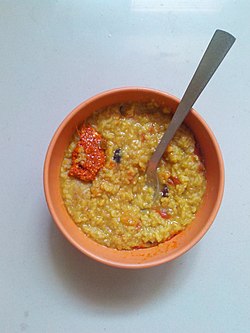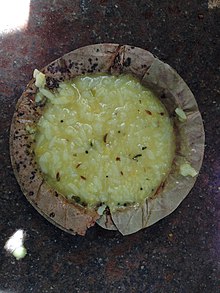Khichdi (dish)
Khichdi[1][2][3][4][5] or Khichri (Hindi: खिचड़ी, romanized: khicṛī, pronounced [ˈkʰɪtʃɽiː], Bengali: খিচুড়ি) is a dish in South Asian cuisine made of rice and lentils (dal), but other variations include bajra and mung dal khichri. In Indian culture, in several regions, especially in the northern areas, it is considered one of the first solid foods that babies eat.[6] Hindus, mainly from north/northwest, who avoid eating grains during fasting, eat Sabudana khichri made from sago.[7][8] In the southern part of India, however, the word khichri is not that popular. While people of Tamil Nadu and Andhra regions cook Pongal, and Kannadigas prepare Huggi which is mung dal Khichidi and Bisi bele bhath, a pigeon pea variation with vegetables, Keralites have no similar dish. Khichri is a salty porridge. Dalia is another similar sweet porridge made from the crushed wheat or barley mixed with sugar and milk.[9]
 A bowl of dal khichri served with achar | |
| Alternative names | Khichdi, khichadi, khichdee, khichadi, khichuri (Bengali), khisiri (Assamese), khechidi/khechudi (Odia), kisuri (Sylheti), khichari, kitcheree, kitchree |
|---|---|
| Region or state | Indian Subcontinent |
| Associated national cuisine | India, Bangladesh, Pakistan, Nepal, Trinidad and Tobago, Guyana, Suriname, Fiji, Mauritius |
| Main ingredients | Rice, lentils, spices |
| Variations | Mung dal khichri, bajra-ri-khichri (Rajasthani millet khichri), sadi khichri (lentil and rice khichri) |
Khichdi was the inspiration for Anglo-Indian kedgeree[10] and was said to be related to the Egyptian koshary, though the latter has more Italian influence.[11]
Etymology and spellingEdit
The word Khichdī is derived from Sanskrit खिच्चा khiccā,[12] a dish of rice and legumes.[13]
Some divergence of transliteration may be noted in the third consonant in the word khicṛī. The sound is the retroflex flap [ɽ], which is written in Hindi with the Devanagari letter ⟨ड़⟩, and in Urdu script with the Perso-Arabic letter ⟨ڑ⟩. In Hindustani phonology, the etymological origin of the retroflex flap was /ɖ/ when it occurred between vowels.[14] Hence in Devanagari the letter ⟨ड⟩, representing /ɖ/, was adapted to write /ɽ/ by adding a diacritic under it. In Urdu script, the phonological quality of the flap was represented by adapting the letter ⟨ر⟩, representing /r/, with a diacritic added above it to indicate the retroflex quality. The occurrence of this consonant in the word khicṛī has given rise to two alternative spellings in English: khichri, which reflects its phonology, and khichdi, which reflects its etymology.
HistoryEdit
The Greek king Seleucus during his campaign in India (305-303 BC), mentioned that rice with pulses is very popular among people of the Indian subcontinent.[3] Strabo also notes that Indian food mainly consisted of rice porridge and a beverage made of rice, presently called Arak.[15] The Moroccan traveller Ibn Battuta mentions khichdi as a dish in India composed of rice and mung beans, during his stay around 1350.[16] khichdi is described in the writings of Afanasiy Nikitin, a Russian adventurer who travelled to the Indian subcontinent in the 15th century. It was very popular with the Mughals, especially Jahangir. Ain-i-Akbari, a 16th-century document, written by Mughal Emperor Akbar's vizier, Abu'l-Fazl ibn Mubarak, mentions the recipe for khichdi, which gives seven variations.[17] There is an anecdotal story featuring Akbar, Birbal and khichdi.[5]
The Anglo-Indian dish Kedgeree is thought to derive from khichri.[10][18]
Regional variationsEdit
Khichdi is a very popular dish across the Indian subcontinent, including in Bangladesh, Nepal and Pakistan also. The dish is widely prepared in many Indian states, such as Punjab, Haryana, Rajasthan, Karnataka, Telangana, Madhya Pradesh, Gujarat, Tamilnadu, Andhra Pradesh, West Bengal, Assam, Bihar, Jharkhand, Uttar Pradesh, Odisha, and Maharashtra.[19] Vegetables such as cauliflower, potato, and green peas are commonly added.
HaryanaEdit
Khichdi is a popular traditional staple in Haryana, specially in the rural areas. Haryanvi khichdi is made from pearl millet and mung dal (split mung bean) pounded in mortar (unkhal), and often eaten by mixing with warm ghee or lassi, or even yogurt.[20][21][22][9] Sometimes, jowar is also mixed with bajra and mung dal.[9]Khichri is salty and dalia is another similar sweet porridge made from the crushed wheat or barley mixed with sugar and milk.[9]
Hyderabadi MuslimsEdit
The Hyderabadi Muslim community, of the erstwhile Hyderabad State, in present-day Telangana, Marathwada, and Kalyana-Karnataka regions, make khichdi as a common breakfast dish, and is an important part of Hyderabadi cuisine.[4] The dish is called khichri, kheema, khatta, or other switch-around versions of the previous, named after the three parts of the meal, Khichri, ground beef, and a sour sauce, made of tamarind and sesame.[23]
Khichra and khichriEdit
Khichra is similar to haleem, a meat dish, while khichri is a vegetarian dish with rice and pulses or lentils, with no spices.
National dish controversyEdit
In 2017, Indian media unofficially designated it as the "national dish", as it is being globally promoted by the government of India as "queen of all foods". The report that the government may designate khichri as India's "national dish" brought significant ridicule from the opposition politicians.[24]
However, India's Minister of Food Processing Industries Mrs. Harsimrat Kaur Badal clarified that while Khichdi is considered nutritious and healthy food in India, the government did not have any plans to designate a national food.[2][25][26]
In popular cultureEdit
Khichdi has lent its name to media synonymous with ensembles or potpourri as depicted in the popular culture through movies such as Khichdi: The Movie, and TV sitcoms such as Khichdi (franchise), Khichdi (TV series), and Instant Khichdi.
See alsoEdit
ReferencesEdit
- ↑ "Khichdi Indian Recipe", indianhealthyrecipes.com
- ↑ 2.0 2.1 "Government to designate 'khichdi' as national dish", Business Standard, 1 November 2017.
- ↑ 3.0 3.1 "Khichdi–A Comfort Food – India Currents". Archived from the original on 16 February 2013. Retrieved 1 January 2015.
- ↑ 4.0 4.1 "Hyderabadi Brunch: Khichdi Khatta Kheema". talkistania. 15 February 2013. Retrieved 22 August 2016.
- ↑ 5.0 5.1 "Cooking The Khichdi is one of Birbal Stories". Retrieved 1 January 2015.
- ↑ Hetal of MasterChef U.S. season 6
- ↑ Sean Williams, 2015, "The Ethnomusicologists' Cookbook, Volume II: Complete Meals from around the world", Routledge Taylor & Francis group, page 37.
- ↑ Uma Aggarwal, 2009, "The Exquisite World of Indian Cuisine", Allied Publications, page 106.
- ↑ 9.0 9.1 9.2 9.3 Charmaine O' Brien, 2013, "The Penguin Food Guide to India", Penguin Books Penguin Books.
- ↑ 10.0 10.1 Lobscouse and Spotted Dog; Which It's a Gastronomic Companion to the Aubrey/Maturin Novels, Anne Chotzinoff Grossman and Lisa Grossman Thomas, Norton, 1997, p. 12. ISBN 978-0-393-32094-7
- ↑ 'Khichuri': An Ancient Indian Comfort Dish With A Global Influence, NPR. 20 July 2017.
- ↑ R. S. McGregor, ed. (1997). The Oxford Hindi-English Dictionary. Oxford University Press. p. 237. ISBN 978-0-19-864339-5.
- ↑ Monier-Williams, Monier (1995). A Sanskrit-English Dictionary. Delhi: Motilal Banarsidass. p. 339. ISBN 81-208-0065-6. Retrieved 29 June 2010.
- ↑ Masica, Colin P. (1991). The Indo-Aryan Languages. Cambridge University Press. pp. 97–98. ISBN 0-521-23420-4. Retrieved 29 June 2010.
- ↑ Reddy, Anjana (2016). "Archaeology of Indo-Gulf Relations in the Early Historic Period: The Ceramic Evidence". In Himanshu Prabha Ray (ed.). Bridging the Gulf: Maritime Cultural Heritage of the Western Indian Ocean. New Delhi: Manohar Publishers. p. 68. ISBN 978-93-5098-143-6.
- ↑ "Rehla of Ibn Battuta". Retrieved 21 March 2015.
- ↑ Recipes for Dishes Archived 2011-07-27 at the Wayback Machine Ain-i-Akbari, by Abu'l-Fazl ibn Mubarak. English tr. by Heinrich Blochmann and Colonel Henry Sullivan Jarrett, 1873–1907. The Asiatic Society of Bengal, Calcutta, Volume I, Chapter 24, page 59. "3. K'hichri. Rice, split dal, and ghee 5 s. of each; ⅓ s. salt: this gives seven dishes."
- ↑ Smith, Delia. "Buttery Kedgeree". Delia Smith's Complete Cookery Course. Retrieved 10 March 2008.
- ↑ Chatterjee, Priyadarshini (10 February 2017). "From Kashmir to Karnataka, khichdi is the one true underestimated food of India". Scroll.in. Retrieved 10 February 2017.
- ↑ 1990, "Haryana District Gazetteers: Sonipat", Government of Haryana publication, Page 83.
- ↑ 1912, "Haryana District Gazetteers: Delhi district gazetteer", Government of India Gazetteers Organisation, Page 90.
- ↑ 1987, "Haryana District Gazetteers: Hisar", Government of Haryana publication, Page 65.
- ↑ "My Kitchen's Aroma: Khichdi Keema Khatta". mykitchenaroma.blogspot.ca. Retrieved 22 August 2016.
- ↑ Nothing cooking: Khichdi not national dish, says minister after Twitter storm, Hindustan Times. 2 November 2017.
- ↑ "'Fictitious' Says Union Minister Harsimrat Kaur Badal. Khichdi Won't be the National Dish", NDTV, 1 November 2017.
- ↑ "Khichdi not national food, clarifies Harsimrat Kaur Badal". The Hindu. 2 November 2017. Retrieved 22 February 2020.

